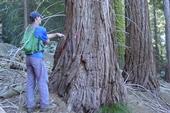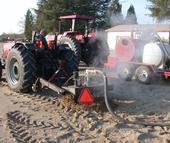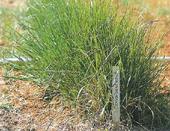- Author: Kim Ingram

Adult and juvenile California spotted owl
During a Sierra Nevada Adaptive Management Project (SNAMP) public meeting, a participant brought up the idea that California spotted owls preferred to nest near forest edges to be closer to foraging habitat and their prey. Principal investigator for the SNAMP Owl Team, Dr. Rocky Gutierrez, charged research fellow Casey Phillips and SNAMP Owl Team project leader Doug Tempel to research this question at SNAMP study sites in the Tahoe and Eldorado National Forests to see if this was...
- Author: John Stumbos

The giant sequoias of the Sierra Nevada are the biggest and among the oldest trees on the planet. Some are 2,000 to 3,000 years old. Forestry scientists from the University of California and Cal Poly, San Luis Obispo, want to learn more about how disturbance factors affect the health of these aging behemoths.
Growth-response studies to date show that tree vigor can increase following moderate intensity disturbances such as prescribed fire or mechanical fire-hazard reduction treatments. Less certain, however, is how giant sequoias respond to lower and higher intensity disturbances. This information is of critical importance to identify the tradeoffs involved in fire prevention treatments or evaluating management...
- Author: Chris M. Webb

Synthetic soil fumigants such as chloropicrin and 1,3-D are used by some commercial growers to control soilborne pathogens, weeds and nematodes prior to planting strawberries, onions, tomatoes, eggplant, peppers and spinach. These fumigants and all other biocidal products with the potential to harm the environment and human health are highly-regulated by the federal Environmental Protection Agency, the state Department of Pesticide Regulation, and county agricultural commissioner's offices.
UC Cooperative Extension farm advisor Oleg Daugovish and his collaborators work hard to find effective, environmentally-safe and economically-viable ways to improve...
- Author: Ann King Filmer

All bets are off in terms of what will happen with plant species migration and crop production as the climate changes globally.
A common assumption has been that native plants and animals would “move,” or migrate, to higher elevations as temperatures rise, to maintain their “preferred” temperatures, but a new report by Jonathan Greenberg at UC Davis, shows that many California plant species moved downhill over the past 70 years.
According to Greenberg, “While the climate warmed significantly in this period, there was also more precipitation. These wetter conditions are allowing plants to exist in warmer locations than they were previously capable...
- Author: Jeannette E. Warnert

California’s role as an emerging world leader in the development of green energy technologies offers the state’s farmers the opportunity to diversify their cropping systems and increase their income.
Sacramento lawmakers have given the California Energy Commission an annual budget of $100 million to support the development of alternative and renewable low-carbon fuels. In addition, the State Alternative Fuels Plan set goals of reducing petroleum dependence by 15 percent and increasing alternative fuels use by 20 percent by 2020. These efforts are meant to help meet the growing fuel demands of the world population while reducing greenhouse gas emissions in California to 1990 levels.
“With the new mandates, there are new...



